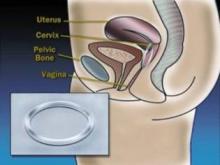SAN DIEGO – The risk of venous thromboembolism in women using an etonogestrel-containing vaginal ring did not differ significantly from the risk in women on combined oral contraceptives over a 4-year period, a prospective cohort study of 33,704 women found.
There were 56 (less than 1%) venous thromboemboli during the study. The rate of venous thromboembolism (VTE) was approximately 9/10,000 woman-years in 16,884 women using the NuvaRing and in 16,820 women on combined oral contraceptives (OCs), Dr. Klaas Heinemann Jr. and his associates reported at the annual meeting of the American College of Obstetricians and Gynecologists.
Subanalyses also found no significant difference in risk when comparing NuvaRing with combined OC regimens that did not contain desogestrel, gestodene, drospirenone, or combinations of those, said Dr. Heinemann, managing director of a private research institute, the Berlin Center for Epidemiology and Health Research.
There were 1,915 serious adverse events during the TASC (Transatlantic Active Surveillance on Cardiovascular Safety of NuvaRing) study. Rates of serious adverse events were less than 300 events/10,000 woman-years in women on NuvaRing or combined OCs and in women who had stopped treatment, but were not pregnant. The risk of serious adverse events did not differ significantly between those groups, but was significantly higher in women who became pregnant, who had 900 serious adverse events per 10,000 woman-years.
The study defined serious adverse events as any adverse event that results in death, a life-threatening experience, inpatient hospitalization, persistent or significant disability or incapacity, or the need for medical or surgical intervention to prevent one of these events. Most serious adverse events involved injury, the genitourinary system (ovarian cysts, kidney stones, salpingitis, UTI), or the digestive system (appendectomy).
From 2007 to 2012, the investigators followed patients recruited by ob.gyns. at more than 3,000 centers in the United States and five European countries, with 51% of the women enrolled at U.S. centers. Follow-up was by patient questionnaire at 6, 12, 24, 36, and 48 months, with all patient-reported outcomes verified with the attending physician. Three percent of patients were lost to follow-up in each of the NuvaRing and combined OC groups. The investigators controlled for the effects of previous hormonal contraceptive use, the patient’s medical history, and a family history of VTE.
Patients in the NuvaRing and combined OC groups did not differ significantly in age, although use of NuvaRing was slightly lower in women younger than 20 years, compared with use of OCs. In the NuvaRing group, 9% were younger than 20 years, 55% were aged 20-29 years, 27% were aged 30-39 years, and 9% were 40 years or older. In the combined OCs group, the distribution was 16%, 54%, 22%, and 8%, respectively.
The two groups also did not differ significantly in body mass index (BMI), smoking rates, regular use of medications, or history of VTE or arterial thromboembolism. Less than 2% in each group had a history of VTE or arterial thromboembolism, a nonsignificant difference.
Compared with patients in Europe, U.S. patients were more likely to have a BMI of 30 kg/m2 or greater (25% vs. 13%), were half as likely to smoke (16% vs. 30%), and were more likely to be using medication regularly, mainly psychotropic medications (23% vs. 10%), Dr. Heinemann said.
The study won first prize from the ACOG’s committee on the scientific program among meeting papers on current clinical and basic investigations.
The findings are limited by the observational design of the study. Information on specific gene mutations were not available for many patients, but the predictive value of these mutations for VTE is low compared with the predictive value of family history, he said.
The study included women who were using contraceptives for the first time or switching from other contraceptives or previous users of NuvaRing who had at least a 4-week break since previous use. Long-term users of these contraceptive methods were excluded from the study because the risk for VTE is highest in the first few months of use.
The study was funded by Merck, which markets NuvaRing. Dr. Heinemann reported no other financial disclosures.



